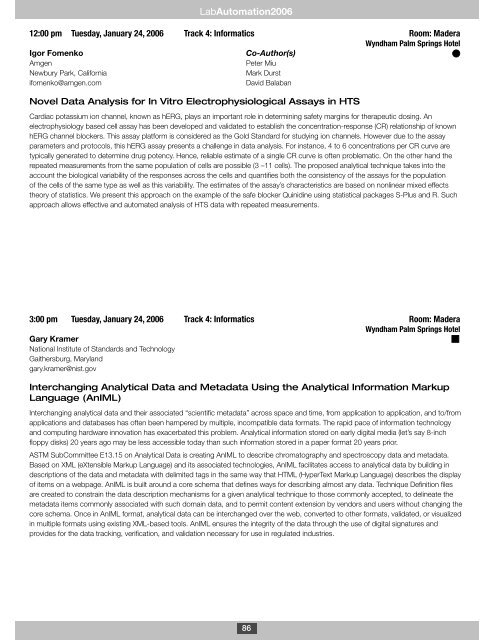LabAutomation 2006 - SLAS
LabAutomation 2006 - SLAS
LabAutomation 2006 - SLAS
You also want an ePaper? Increase the reach of your titles
YUMPU automatically turns print PDFs into web optimized ePapers that Google loves.
<strong>LabAutomation</strong><strong>2006</strong><br />
12:00 pm Tuesday, January 24, <strong>2006</strong> Track 4: Informatics Room: Madera<br />
Wyndham Palm Springs Hotel<br />
Igor Fomenko<br />
Co-Author(s)<br />
Amgen<br />
Peter Miu<br />
Newbury Park, California<br />
Mark Durst<br />
ifomenko@amgen.com<br />
David Balaban<br />
Novel Data Analysis for In Vitro Electrophysiological Assays in HTS<br />
Cardiac potassium ion channel, known as hERG, plays an important role in determining safety margins for therapeutic dosing. An<br />
electrophysiology based cell assay has been developed and validated to establish the concentration-response (CR) relationship of known<br />
hERG channel blockers. This assay platform is considered as the Gold Standard for studying ion channels. However due to the assay<br />
parameters and protocols, this hERG assay presents a challenge in data analysis. For instance, 4 to 6 concentrations per CR curve are<br />
typically generated to determine drug potency. Hence, reliable estimate of a single CR curve is often problematic. On the other hand the<br />
repeated measurements from the same population of cells are possible (3 –11 cells). The proposed analytical technique takes into the<br />
account the biological variability of the responses across the cells and quantifies both the consistency of the assays for the population<br />
of the cells of the same type as well as this variability. The estimates of the assay’s characteristics are based on nonlinear mixed effects<br />
theory of statistics. We present this approach on the example of the safe blocker Quinidine using statistical packages S-Plus and R. Such<br />
approach allows effective and automated analysis of HTS data with repeated measurements.<br />
3:00 pm Tuesday, January 24, <strong>2006</strong> Track 4: Informatics Room: Madera<br />
Wyndham Palm Springs Hotel<br />
Gary Kramer<br />
National Institute of Standards and Technology<br />
Gaithersburg, Maryland<br />
gary.kramer@nist.gov<br />
Interchanging Analytical Data and Metadata Using the Analytical Information Markup<br />
Language (AnIML)<br />
Interchanging analytical data and their associated “scientific metadata” across space and time, from application to application, and to/from<br />
applications and databases has often been hampered by multiple, incompatible data formats. The rapid pace of information technology<br />
and computing hardware innovation has exacerbated this problem. Analytical information stored on early digital media (let’s say 8-inch<br />
floppy disks) 20 years ago may be less accessible today than such information stored in a paper format 20 years prior.<br />
ASTM SubCommittee E13.15 on Analytical Data is creating AnIML to describe chromatography and spectroscopy data and metadata.<br />
Based on XML (eXtensible Markup Language) and its associated technologies, AnIML facilitates access to analytical data by building in<br />
descriptions of the data and metadata with delimited tags in the same way that HTML (HyperText Markup Language) describes the display<br />
of items on a webpage. AnIML is built around a core schema that defines ways for describing almost any data. Technique Definition files<br />
are created to constrain the data description mechanisms for a given analytical technique to those commonly accepted, to delineate the<br />
metadata items commonly associated with such domain data, and to permit content extension by vendors and users without changing the<br />
core schema. Once in AnIML format, analytical data can be interchanged over the web, converted to other formats, validated, or visualized<br />
in multiple formats using existing XML-based tools. AnIML ensures the integrity of the data through the use of digital signatures and<br />
provides for the data tracking, verification, and validation necessary for use in regulated industries.<br />
86
















